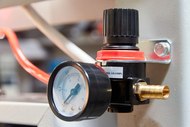How Refrigerated Air Dryers Work
Posted by AVP on Jan 16th 2022
If you use compressed air as a power source for operating machinery or pneumatic tools, you need more than an air compressor. You need a compressed air dryer as well - but there are many different types of compressed air dryers. In this article, we’ll take a closer look specifically at one type of air dryer - refrigerated air dryers - and how they work.
Why Air Needs to Be Dried
When air is compressed, liquids and other contaminants condense out of it. In addition to water, there may be oils and other types of particulate material present. These can damage pneumatic equipment, clog pipes, cause corrosion, and result in costly repairs and downtime.
The solution to all of these issues is to dry compressed air thoroughly before use with a compressed air dryer.
Some air dryers use desiccants to remove moisture from compressed air. Another type, known as a refrigerated air dryer, cools off the air, forcing the liquid within it to condense, before removing it with a special trap or water separator.
How a Refrigerated Air Dryer Works
Refrigerated air dryers operate according to a principle similar to an air conditioning unit. The air dryer contains both an evaporator and a compressor, as well as a refrigerant that is used to absorb and release heat.
First, warm, wet air enters the refrigerated air dryer, and a heat exchanger absorbs the thermal energy from the compressed air, cooling it off. The energy flows out of the compressed air and into the liquid refrigerant, heating it up.
When the air cools off inside the refrigerated air dryer, the water vapor condenses out of it. This water is collected in a water trap and through discharge lines where the water can be disposed of.
This cold air is then reheated to the ambient temperature before being released through the refrigerated air dryer’s outlet. Because much of the moisture has been condensed out of the air, this warm compressed air will now be much drier.
There are two main types of refrigerated air dryers, being cycling and non-cycling models. Cycling air dryers are capable of increasing or decreasing cooling capacity according to usage and other considerations, making them more energy-efficient and effective.
Non-cycling refrigerated air dryers start up and shut down intermittently in order to maintain the desired temperature of operation, instead of increasing or decreasing capacity. As a result, these are more affordable, incur lower maintenance costs, and are more common.
Why Are Refrigerated Air Dryers Common?
Refrigerated air dryers are among the most commonly encountered types of compressed air dryers, as they offer a wide range of benefits, including the following.
- Simplicity and wide availability: Many refrigerated air dryers offer very simple operations and are very straightforward to work. They’re also widely available.
- Low upfront costs: These types of compressed air dryers are among the most affordable of all, making them attractive to many different businesses and industries.
- Low maintenance costs: Not only do refrigerated air dryers typically incur low upfront costs, but they are easy to maintain and often very affordable to operate in the long run as well.
What to Look for in a Refrigerated Air Dryer:
There are a few key considerations you should make before investing resources into a refrigerated air dryer. These are some of the most important.
- Maximum operating pressure: The maximum operating pressure of the air dryer you intend to use must be compatible with the pressure of the air delivered by your compressor. That is, you cannot exceed the dryer’s maximum operating pressure.
- Maximum external temperature: Dryers can overheat and fail or shut down. Pay close attention to maximum ambient operating temperature ratings to avoid headaches down the line.
- Inlet temperature: Air dryers are rated with a maximum operating inlet temperature, exceeding which can damage the dryer.
- Maximum flow: Your air dryer must be able to dry air at a faster rate than the rate at which the air compressor system will deliver air to it.

How We Can Help
Here at Air & Vacuum Process, Inc., we offer three main types of refrigerated compressed air dryers.
- Non-cycling refrigerated dryers: Our Aircel non-cycling compressed air dryers deliver high efficiencies at variable flow conditions.
- High-inlet temperature refrigerated air dryers: These refrigerated air dryers combine oversized refrigeration circuits and high-efficiency heat exchangers with fully automatic operation.
- High capacity cycling air dryers: These systems use multiple compressors and a thermal storage medium to provide a high capacity of dried, compressed air supply - between 2,500 to 30,000 SCFM.
These air dryers are designed to conserve energy while delivering compressed air systems with a consistent flow of high-quality, dry air. If you have any questions about how any of our compressed air dryers works or would like help choosing a dryer that meets the specific needs of your organization, please get in contact with us at 866-660-0208 or at Sales@AirVacuumProcess.com.
